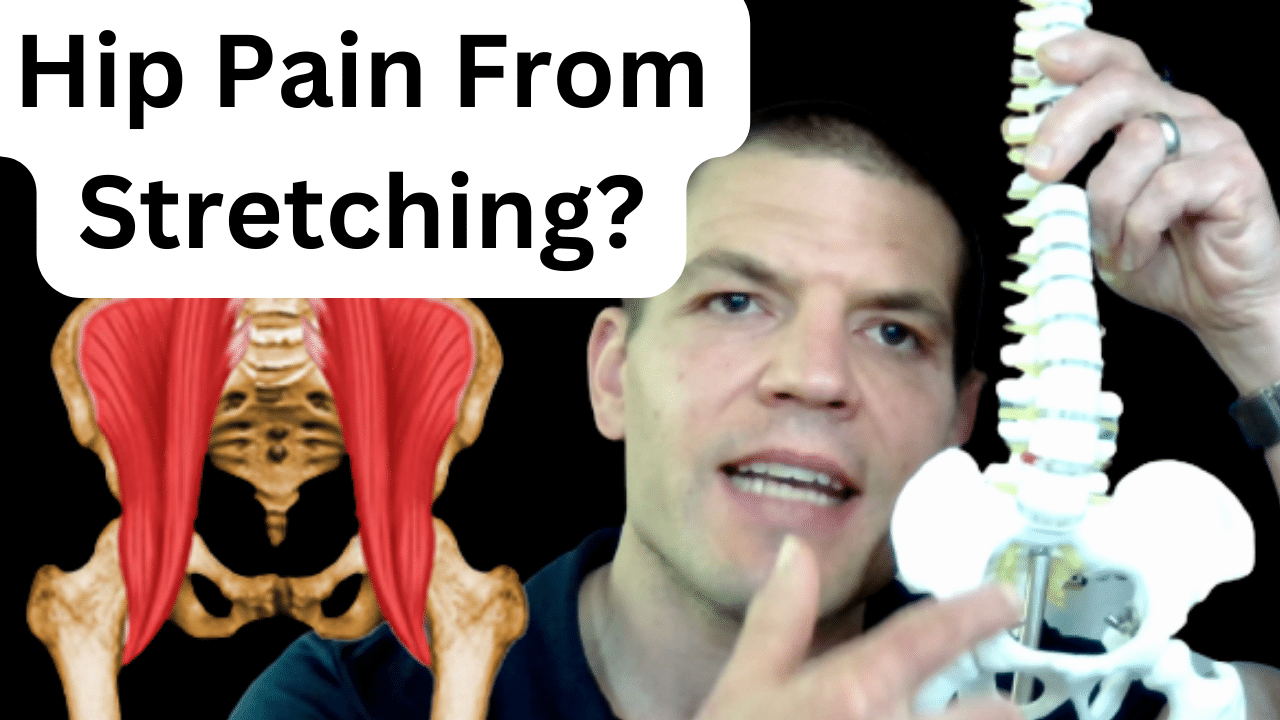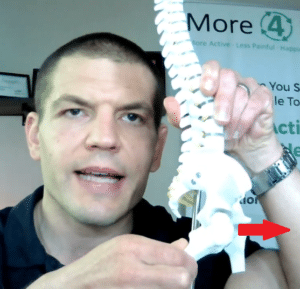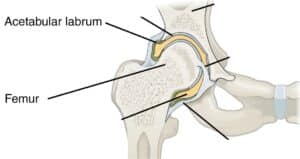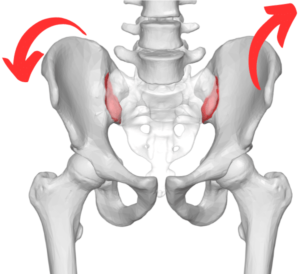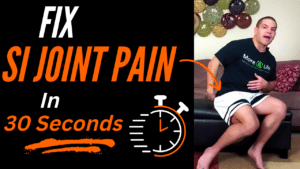Can You Get Hip Pain From Stretching?
You CAN get hip pain from stretching.
A lot of people think that stretching is good for preventing injuries and recovering from injuries, and sometimes it is. However, as with most things, there's a happy medium. You don't want to be too stiff, but you also don't want to be too flexible.
In fact, being too flexible can actually CAUSE injuries
Watch the video to learn 3 causes of hip pain from stretching and how to prevent hip pain after stretching.
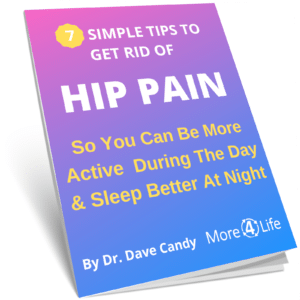
What Causes Hip Pain From Stretching?
Who gets hip pain from stretching?
Most people who get hip pain from stretching are people who probably really don't need to be stretching in the first place.
There are certain conditions that make people genetically a little bit more hypermobile or hyperflexible. That means that your joints and your ligaments are just a little bit more stretchy than the average person's.
A lot of times, there is a congenital link to that. For example, Ehlers-Danlos syndrome is one condition where people may be a little bit hypermobile or hyperflexible.
People who are hyperflexible tend to gravitate towards sports like dancing, gymnastics, cheerleading, or even martial arts. In those sports, being excessively flexible gives you a competitive advantage, but that doesn't always come without cost.
Sometimes that cost means you end up getting injured more because your joints aren't necessarily supposed to go to those extreme ranges of motion.
Now, does that mean that you can't or shouldn't participate in those sports?
No. You just have to be a little bit smarter about how you stretch.
Front Of Hip Pain From Stretching
One common instance where people can get hip pain from stretching is when they do a splits or a hip flexor stretch. In these stretches, one leg is going back, and the other leg is going forward.
So you go into more of like a lunge position or especially doing a front splits position when one leg is going behind you like that.
When your leg goes excessively behind you, the head of the femur (the "ball of this ball and socket joint") starts to glide forward.
When that happens, the head of the femur can press into the front part of the labrum, which is a rim of cartilage that deepens the hip socket.
This can cause front of hip pain from stretching.
Additionally the head of the femur can also glide forward into your iliopsoas tendon. The iliopsoas is a combined hip flexor muscle made up of two muscles: the iliacus and the psoas.
Your iliopsoas tendon runs right in front of your hip joint. If the ball of your hip glides too far forward when stretching your hip flexors, you can get pain in the front of your hip after stretching.
So what do you do if you get front of hip pain from stretching?
The obvious solution is that if you don't NEED to go into those extreme ranges of motion, then just don't stretch that far.
If you're not a dancer, gymnast, or cheerleader, and you don't need to do the splits, just don't stretch that far.
Stop at the point where you feel a good stretch, and don't go to the point where it becomes painful.
However, if you DO need to push to the extremes of flexibility for your sport, then it's all about balance.
In that case, you need to get the back of your hip equally as flexible as the front.
If the back part of your hip joint is stiffer than the front, your hip joint is going to take the path of least resistance and glide forward.
The all-fours rock back exercise is good hip mobility stretch for the back of the hip.
Stretch To Relieve Front Of Hip Pain
To do this stretch, kneel on hands and knees and then rock backward, kind of like the child's pose or the prayer stretch.
However, you want to keep a slight arch in your back as shown below.
This stretch uses your body weight to help push your hip joint backward in the socket. That in turn helps get improve the flexibility of the back part of the hip.
Strengthen The Hip Rotator Muscles
It's also important to develop the hip rotator muscles.
These muscle largely run from your sacrum to your hip.
They're kind of like the rotator cuff muscles of your hip. They help hold the ball securely in the socket and don't let it glide too far forwards.
One common strengthening exercises for the hip rotator muscles is the clamshell exercise.
It's also important to be able to balance your body over one leg, particularly if you're involved in sports like dancing or gymnastics.
So that's the first cause of hip pain from stretching.
Sacroiliac Joint Pain From Stretching
The second cause of hip pain from stretching comes from a similar hip flexor stretch to extremes or doing a front split.
However, instead of the hip pain actually being at the hip joint, it can happen at the sacroiliac (SI) joint in the back of the pelvis.
Even though that's not technically your hip joint per se, many people refer to their SI joint area as their "hip".
The sacroiliac joint is where the pelvic bones join with the spine.
If one of your legs is going forwards while the other joint is coming backwards, that can create a twisting force at your SI joints.
In turn, that can create pain in the back of your hip from stretching.
So how do you correct SI joint pain from stretching?
If you're stretching too far with one leg forwards and the opposite leg backward, that can cause an SI joint dysfunction. Luckily, you can often fix the SI joint pain by stretching the opposite way.
Sciatica From Stretching
The third type of hip pain that you might get from stretching actually isn't really a hip problem at all.
It's a problem with your sciatic nerve.
When you stretch your hamstrings, that puts tension on your sciatic nerve.
If you stretch too far, especially if your muscles are a little bit more hyperflexible to begin with, you may irritate your sciatic nerve.
That can actually pull on the nerve roots in your back or where the sciatic nerve runs under your piriformis here in your hip.
Stretching your hamstring too far can cause sciatica, which will give you the feeling of pain in the back of your hip or the back of your leg.
The rule of thumb to prevent this from happening is: don't stretch to the point of pain.
I've actually had a patient who went to physical therapy somewhere else before coming to see me. The therapist stretched them a bit too far. Unfortunately the patient ended up developing sciatica as a result.
If you're having therapy, it's important to give the therapist feedback. Make sure to tell them to stop if you are experiencing pain.
Often when people get overstretched in physical therapy, it's usually a younger physical therapist who isn't as experienced and doesn't necessarily have the feel to know for when your muscles have reached their endpoint.
So, it is important to have a good, experienced physical therapist who can read your body language and also has the tactile feel to know when your tissues are at their endpoint even if you're not reporting pain.
That's especially true if you already have some kind of back pain, hip pain, or sciatica.
Conclusion
So those are the 3 causes of hip pain from stretching. The overall take-home points are to avoid stretching to extreme ranges of motion or to the point where you're having pain.
Now, if you're in the St. Louis area and you need an experienced physical therapist to help you relieve back or hip pain without over-stretching you and potentially making the problem worse, tap the button below to request an appointment with one of our specialist physical therapists.

